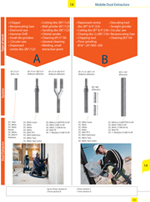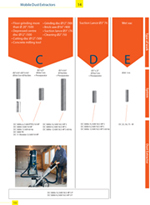|
1. Capacity/Weight
Check the capacity of the unit in relation to its weight and portability. The motor power does not determine capacity, but rather airflow and vacuum generation (cfm/m3/h x inwg/kPa) available to the operator (normally at 40–80 inwg/10-20 kPa). The lower the unit weight for comparable capacity, the easier the unit will be to move and use.
2. Material Handling
Dust, bulky materials, chips and strips can be collected and transported with vacuum. When the material volume is large, efficient handling saves time and money. Ergonomic handling of the unit and the collected material is also important. The system design should minimize the possibility of dust contamination during collection bag and filter changes. The dust collected in the system should be contained during these activities.
3. Sound Level
Even in environments where the sound level is not considered harmful, remember that each additional source increases the overall level. Compare the sound level rating of the unit with measurements from the subject environment. To have a zero net gain, the sound level of the unit should be at least 5 dB(A) below the ambient level.
4. Filtration
Choose the filtration system so the unit does not lose capacity after several minutes of use. Dustcontrol dust extractors separate the dust in three inter-related steps:
1. Separation of coarse material in the cyclone –
A good quality cyclone has the right characteristics relative to thecapacity of the vacuum producer. Generally, the longer the cyclone, the better.
2. Fine filtration – The fine filter protects the HEPA filter and has a lower replacement cost. To extend the life of the HEPA filter, Dustcontrol recommends that you replace the fine filter frequently. A conical pleated filter cartridge achieves the highest air to cloth ratio of any filter design on the market. The machine should also have a filter condition indicator and an effective filter cleaning system. For some applications, such as concrete floor grinding, you may require a PTFE or TeflonTM coated fine filter.
3. HEPA filtration – Do not compromise your health, very close to 100 % filter efficiency is achievable. When the air is exhausted back into the working environment, a HEPA H13 filter is highly recommended. If elimination of hazardous dust is the target, then why release respirable dust back into the working environment?
5. Suction Casings
Dustcontrol developed the source extraction concept 35 years ago! Source extraction is the most effective method for maintaining a clean working environment. A Dustcontrol suction casing captures dust or fume directly at the point of generation. Practically all popular hand power tools can be equipped with a suction casing. Recently, some machine manufacturers have integrated their own suction casings. With Dustcontrol’s connecting sleeves, part nos. 2109 (1”/25mm), 2132 (1.25”/32mm) or 2114 (1.5”/38mm), they can connect to Dustcontrol dust extractors. Enjoy dust-free operation of your hand held tools by upgrading to a Dustcontrol dust extractor.
|
|
6. Applications
Concrete Dust Tough applications, such as concrete grinding, demand a lot from a dust extractor and filter. Since there are high volumes of very fine particulate, you may need a PTFE filter or TeflonTM treated filter. A pre-separator is also recommended for large floor grinding machines.
The DC 3800 Twin with TeflonTM filter or the DC 5800 with PTFE filter are the most suitable dust extractors for this type of work.
Fluids
All Dustcontrol’s dust extractors can be used for vacuuming non- flammable liquids in small quantities. However, Dustcontrol also offers a dedicated liquid extractor for larger quantities such as concrete coring.
Metal Chip/Swarf
A steel container is preferred when vacuuming sharp items such as metal chips. All dust extractors can be ordered with a steel container.
Hazardous Materials Special precautions must be taken when dealing with hazardous materials such as silica dust and PCB (health hazardous chemicals). First, a machine with at least a HEPA H13 filter is a must. Second, suction casings are needed for your tools to avoid hazardous dust becoming airborne. Third, an additional air cleaner is required to clean the air in your working environment. Finally, protect yourself with mask, eye-wear, and protective clothing.
Explosive Environments Not only liquids or gases can be explosive. Also very fine dust particles mixed with air can be explosive. A tiny spark from a static discharge or a mechanical spark can set off an explosion inside a dust extractor. NFPA 68 as well as other NFPA regulations stipulate certain arrangements, configurations and measures for design of a dust extraction or vacuum cleaning system intended for use with an explosive dust. Dustcontrol can design your system for compliance and foremost, safe operation with respect to these engineering guidlines.
7. The Right Size
Two things determine the most suitable dust extractor required for a given application:
First, the size of the suction casing/nozzle, combined with the type of operation, determines the required airflow. In turn this influences the choice of a suitable dust extractor, taking into account the filter area and the dimension of the inlet.
Second, the longer the hose and tubing runs, the greater the pressure drop in the system will be. Greater pressure generation is required from the dust extractor when handling large quantities of material (heavy cleaning, suction lance etc.)
 
|
 United Kingdom
United Kingdom  Sverige
Sverige  Deutschland
Deutschland  Suomi
Suomi  Austria
Austria  United States
United States  .com
.com  France
France 


 01 53 30 79 69
01 53 30 79 69
